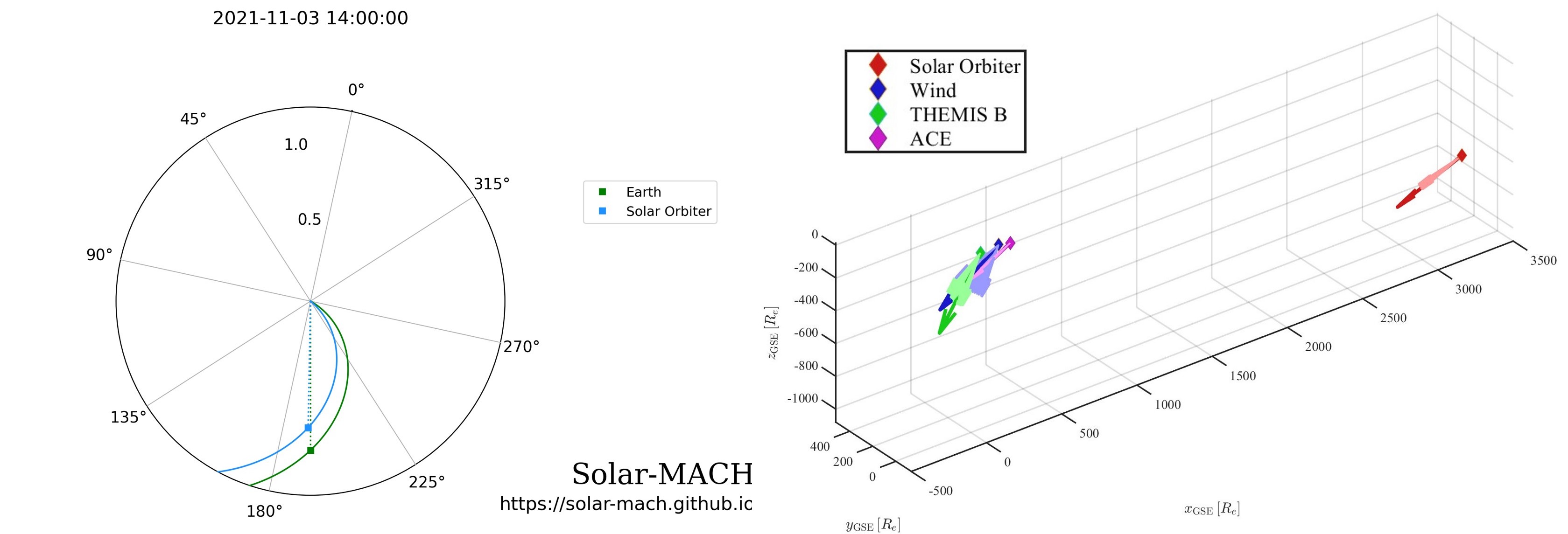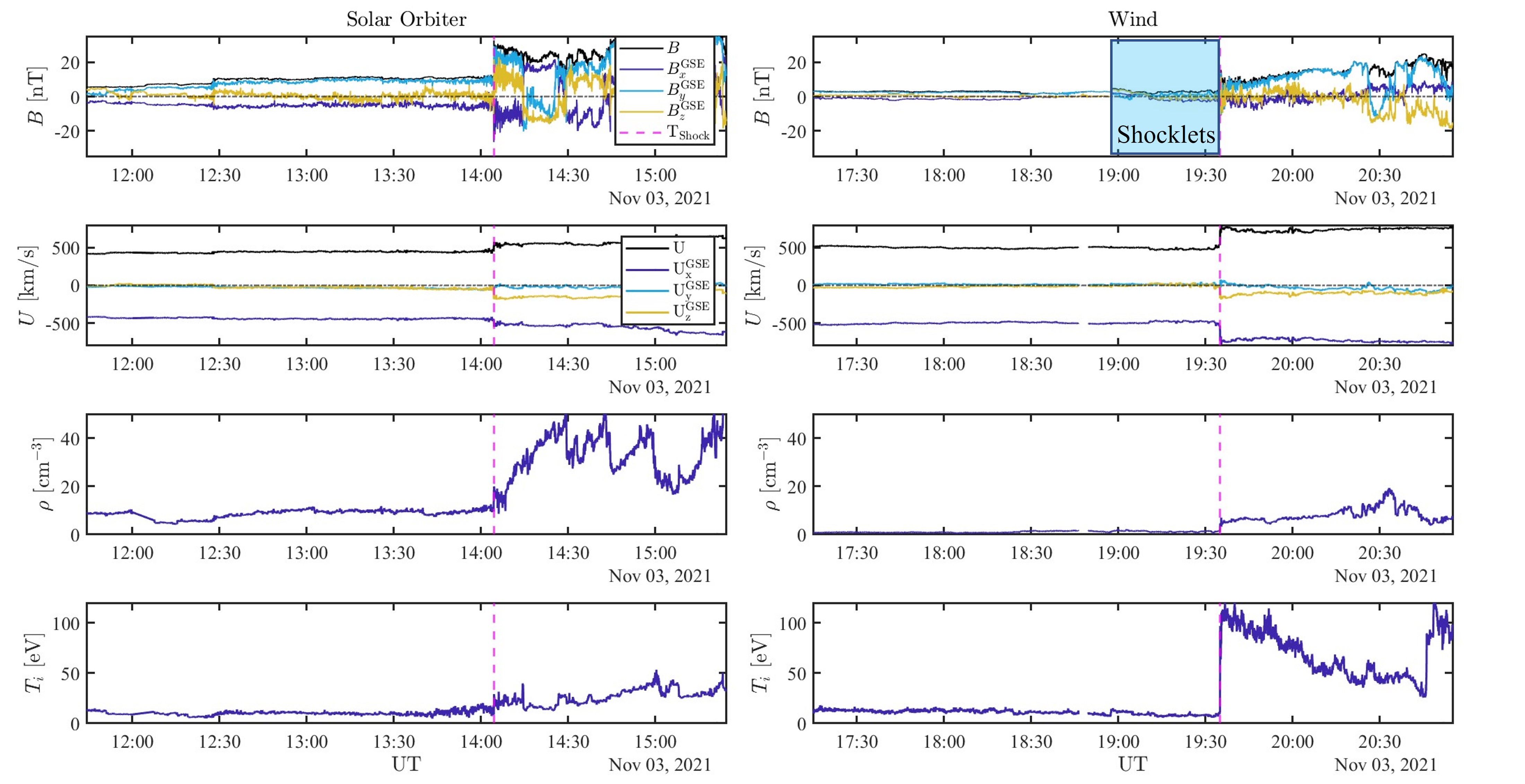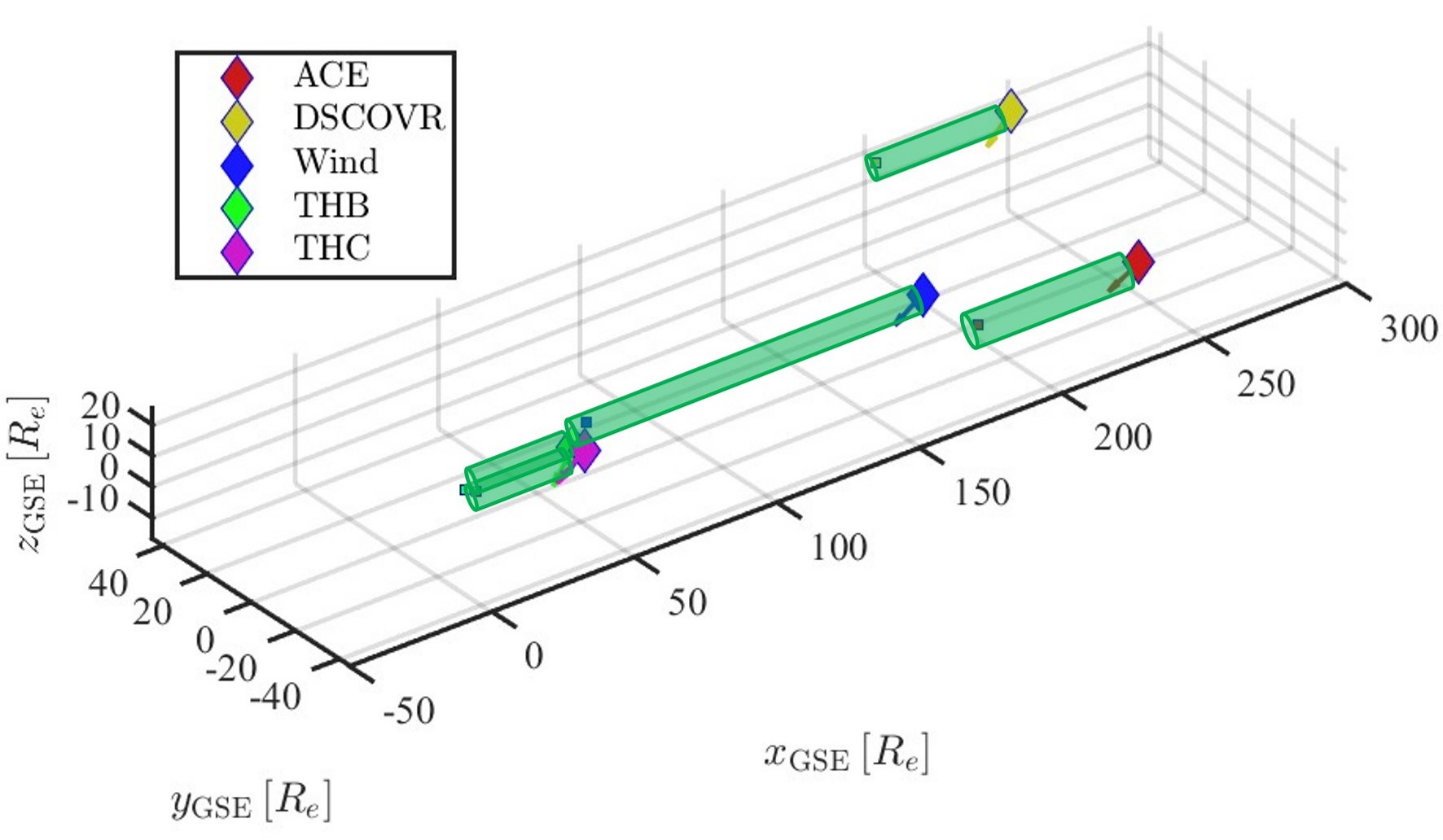Science nugget: An interesting interplanetary shock - Solar Orbiter
An interesting interplanetary shock
(Solar Orbiter nugget #10 by D. Trotta1, H. Hietala1,2, T. Horbury1, N. Dresing3, R. Vainio3, L. Wilson4, I. Plotnikov5, E. Kilpua6 and the MAG team)
Introduction
A particularly interesting aspect of the Solar Orbiter exploration is the possibility to study interplanetary (IP) shock waves using datasets previously unavailable in terms of quality and heliocentric distances. IP shocks travel in the heliosphere due to solar activity phenomena such as Coronal Mass Ejections (CME) and Stream Interaction Regions (SIR), are less well-observed than Earth’s bow shock and play an important role for the overall heliosphere energetics [1].
Using the magnetometer MAG [2] data to measure magnetic field, together with the Solar Wind Analyser [3] Proton Alpha Sensor (PAS) on board Solar Orbiter [4] to address plasma parameters such as bulk flow speed and density, more than 50 IP shocks have been identified so far.
A particularly interesting IP shock crossed Solar Orbiter at 14:04 of November 3rd, 2021, while it was well radially aligned with Earth, at heliocentric distance of 0.8 AU. The shock was seen about 5 hours later by several spacecraft near Earth, where rarely observed structures, known as shocklets, have been found. Such an event provided us with the possibility to study, for the first time with multi-point observations, such rare structures upstream of an IP shock. Furthermore, the Solar Orbiter observations, where no shocklets were found, allowed us to study the environment in which upstream wave steepening happened.

Figure 1: Left: Spacecraft configuration at 14:00 on November 3rd 2021. The Sun is at the centre of the plot, with radial and magnetic field connections to Solar Orbiter and Earth represented by dotted and solid lines, respectively. Right: Three- dimensional overview of the Solar Orbiter, Wind, THEMIS B and ACE spacecraft relative positions (points). Earth is in (0,0,0). Superimposed are the shock normals computed using different averaging windows for each spacecraft, and their mean (light and dark arrows, respectively).
Shocklets in the heliosphere
Collisionless shock waves are characterized by the possibility of particle reflection and subsequent propagation far upstream. One of the phenomena likely induced by shock reflected, energetic ions is the creation of steepened waves in the shock upstream. These structures, called shocklets, are characterised by steep, strong enhancements of the magnetic field magnitude. Shocklets are likely to play an important role for particle acceleration, due to their ability to induce effective pre-conditioning of incoming plasma before its interaction with the shock. The (nonlinear) mechanisms leading to the formation of shocklets are still a matter of debate [5].
Shocklets have been observed in-situ for a large variety of shocks. These include planetary bow shocks, as well as the cometary bow shocks [e.g., 6]. Most of the knowledge about shocklets is due to observations at planetary bow shocks [7]. At IP shocks, shocklets observations are much rarer than planetary bow shocks, making the few available observations of particular interest, as they yield to a better understanding of the origin and evolution of these phenomena. The first of these observations is due to Lucek & Balogh [8], who reported the presence of a shocklet in the magnetic field upstream of shock which crossed the Ulysses spacecraft in 1992. More than a decade later, using the Wind spacecraft [9] data, Wilson et al, [5] reported the presence of 12 shocklets upstream of a strong IP shock recorded on 6 April 2000. This event, labelled by the authors “the unusual event” (with respect to more than 400 other IP shocks observed by Wind), is the second observation of shocklets at IP shocks.
The November 3rd, 2021 event
A fast forward shock driven by a CME was observed on November 3rd, 2021. The left panel of Figure 1 shows an overview of the Sun – Solar Orbiter - Earth system. It can be noted that Solar Orbiter is well radially aligned to Earth, making it a relevant configuration for multi-spacecraft studies. In the right panel of Figure 1, the positions of Solar Orbiter, Wind, THEMIS B [10] and ACE [11] are shown in the three- dimensional space in GSE coordinates (diamonds). Superimposed to the spacecraft position are the shock normal vectors, computed with the systematic approach described in [12]. The dark arrows represent the average shock normal vectors. Our analysis of the shock at several spacecraft revealed that this shock was rather strong with respect to other IP shocks [13], with fast magnetosonic and Alfvenic Mach numbers above 5 in all cases. The shock was therefore likely to show strong spatial and temporal variability. However, by estimating an average shock normal direction, the shock was found to be more parallel near-Earth environment with respect to Solar Orbiter.

Figure 2: Magnetic field magnitude and components, ground-computed ion bulk flow speed, ion density, ion temperature (top to bottom) for the IP shock observed first by Solar Orbiter (left) and later by Wind (right). The magenta line marks the shock crossing, and the blue box highlights the shocklets at Wind.
Figure 2 shows the in-situ observations of the shock as seen by Solar Orbiter (left) and Wind (right). Many interesting features are found, related to the complex environment in which the shock is propagating, characterized by the presence of several structures, as revealed by the magnetic field data. At Solar Orbiter, an upstream structure occurring at about 12:30 can be identified, possibly another small shock pre-conditioning the plasma before it encounters the strong IP shock. The production of energetic particles at the shock seen by Solar Orbiter have been recently investigated by Yang et al. [14]. The blue box of Figure 2 indicates the shocklet field upstream of the shock at Wind. Such structures have been studied in detail, and their presence has been linked to an effective deceleration of the upstream plasma in the shock normal direction, thus highlighting their important role in pre-conditioning the incoming plasma before the shock transition. Shocklets have also been found to have precursors of whistler waves upstream, a feature of their dispersive/transient nature and compatible with previous studies.
Upstream shocklets have been found and studied for the same shock also at ACE, DSCOVR, THB and THC. The upstream field filled with shocklets at these spacecraft highlights again the transient nature of these structures, with variable duration at each spacecraft, even in presence of observations so close in time (the shock crossed Wind and the above spacecraft in less than 30 minutes). Such a configuration has been used to address the portion of space filled with shocklets upstream of the IP shock, an important ingredient to consider when addressing several aspects of particle energisation and energy conversion at strong shocks. Using ACE and DSCOVR observations, a lower limit for such portion of space has been estimated to be of about 71 Earth radii (RE) in the x-y plane and 15 RE in the x-z plane for the transverse directions of the GSE coordinate system, and of at least 110 RE along the x GSE direction. These values correspond to about 2200, 406 and 3500 proton skin depths, using the mean upstream proton density measured by the Wind spacecraft.

Figure 3: Three-dimensional overview of the near -Earth spacecraft in the GSE coordinate system, with the green shaded areas highlighting the shocklet field.
Conclusions
The Solar Orbiter mission is opening a new observational window for in-situ studies of IP shocks. We studied the interesting behaviour of a CME-driven IP shock observed by Solar Orbiter and then near the Earth by ACE [15], DSCOVR [16], Wind, THEMIS B and THEMIS C (in order of shock arrival time). The shock Mach numbers were estimated to be high (>5) for all the spacecraft crossing, and it was likely more quasi-parallel (on average) near Earth, where very rarely observed IP shocklets were found, linked to an effective pre-conditioning the incoming plasma for the shock transition. No shocklets were found at Solar Orbiter, probably due to the higher obliquity of the shock, together with the fact that the shock crossing happens in a very structured portion of the solar wind. Another important ingredient is the shock time evolution: it is possible that the shock at Solar orbiter did not yet produce enough particles for efficient eave steepening upstream. Thanks to such multi-spacecraft observations, we speculate that the higher shock obliquity, together with the structured nature of the shock upstream, create unfavorable conditions for upstream waves to steepen and grow into shocklet structures. Simultaneous observations of shocklets in the near-Earth environment, available for the first time for an IP shock, made possible to estimate the size and nature of the upstream shocklet field for this interesting event.
The relation between the presence of shocklets and the production of energetic particles away from the shock front, as well as a characterisation of such structures from the point of view of scattering of suprathermal particles will be addressed in future work.
This work was published in Trotta et al., MNRAS 520-1 (2023).
Acknowledgments
This work has received funding from the European Unions Horizon 2020 research and innovation programme under grant agreement No. 101004159 (SERPENTINE, www.serpentine-h2020.eu).
The work of HH is supported by the Royal Society award URF\R1\180671. HH thanks discussions in the ISSI International Team 465 ‘Foreshocks across the Heliosphere’. ND is grateful for support by the Turku Collegium for Science, Medicine and Technology of the University of Turku, Finland.
Affiliations
1 The Blackett Laboratory, Department of Physics, Imperial College London, London SW1234, UK
2 School of Physics and Astronomy, Queen Mary University of London, , London E1 4NS, UK
3 Department of Physics and Astronomy, University of Turku, FI-20014 Turku, Finland
4 NASA Goddard Space Flight Center, Greenbelt, MD 20771, USA
5 IRAP, Université Toulouse III – Paul Sabatier, CNRS, CNES, F-31062 Toulouse, France
6 Department of Physics, University of Helsinki, FI-00014 Helsinki, Finland
References
[1] Dryer, Space Sci. Rev., 17, 277 (1975)
[2] Horbury et al., A&A, 642-A9 (2020)
[3] Owen et al., A&A, 642-A16 (2020)
[4] Müller et al., A&A, 642 -A1 (2020)
[5] Wilson III et al., JGR, 114 A10106 (2009)
[6] Tsurutani etal., JGR, 92 -11075 (1987)
[7] Stasiewicz and Klos, MNRAS, 513-5892 (2022)
[8] Lucek and Balogh, GRL, 24-2387 (1997)
[9] Harten and Clark, Space Sci. Rev., 71 -23 (1995)
[10] Auster et al., Space Sci. Rev., 141 – 235 (2008)
[11] Smith et al., Space Sci. Rev., 86 – 613 (1998)
[12] Trotta et al. Fr. As. Spa. Sci., 9 (2022)
[13] Kilpua et al., JGR, 120-4112 (2015)
[14] Yang et al., A&A 673-A73 (2023)
[15] Smith et al., Space Sci. Rev., 86 – 613 (1998)
[16] Szabo et al., SHINE, p.9 (2016)
- Removed a total of (3) style text-align:left;
Nuggets archive
2025
09/04/2025: Bursty acceleration and 3D trajectories of electrons in a solar flare
02/04/2025: Picoflare jets in the coronal holes and their link to the solar wind
19/03/2025: Radial dependence of solar energetic particle peak fluxes and fluences
12/03/2025: Analysis of solar eruptions deflecting in the low corona
05/03/2025: Propagation of particles inside a magnetic cloud: Solar Orbiter insights
19/02/2025: Rotation motions and signatures of the Alfvén waves in a fan-spine topology
12/02/2025: 'Sun'day everyday: 2 years of Solar Orbiter science nuggets that shed light on some of our star's mysteries
22/01/2025: Velocity field in the solar granulation from two-vantage points
15/01/2025: First joint X-ray solar microflare observations with NuSTAR and Solar Orbiter/STIX
2024
18/12/2024: Shocks in tandem : Solar Orbiter observes a fully formed forward-reverse shock pair in the inner heliosphere
11/12/2024: High-energy insights from an escaping coronal mass ejection
04/12/2024: Investigation of Venus plasma tail using the Solar Orbiter, Parker Solar Probe and Bepi Colombo flybys
27/11/2024: Testing the Flux Expansion Factor – Solar Wind Speed Relation with Solar Orbiter data
20/11/2024:The role of small scale EUV brightenings in the quiet Sun coronal heating
13/11/2024: Improved Insights from the Suprathermal Ion Spectrograph on Solar Orbiter
30/10/2024: Temporally resolved Type III solar radio bursts in the frequency range 3-13 MHz
23/10/2024: Resolving proton and alpha beams for improved understanding of plasma kinetics: SWA-PAS observations
25/09/2024: All microflares that accelerate electrons to high-energies are rooted in sunspots
25/09/2024: Connecting Solar Orbiter and L1 measurements of mesoscale solar wind structures to their coronal source using the Adapt-WSA model
18/09/2024: Modelling the global structure of a coronal mass ejection observed by Solar Orbiter and Parker Solar Probe
28/08/2024: Coordinated observations with the Swedish 1m Solar Telescope and Solar Orbiter
21/08/2024: Multi-source connectivity drives heliospheric solar wind variability
14/08/2024: Composition Mosaics from March 2022
19/06/2024: Coordinated Coronal and Heliospheric Observations During the 2024 Total Solar Eclipse
22/05/2024: Real time space weather prediction with Solar Orbiter
15/05/2024: Hard X ray and microwave pulsations: a signature of the flare energy release process
01/02/2024: Relativistic electrons accelerated by an interplanetary shock wave
11/01/2024: Modelling Two Consecutive Energetic Storm Particle Events observed by Solar Orbiter
2023
14/12/2023: Understanding STIX hard X-ray source motions using field extrapolations
16/11/2023: EUI data reveal a "steady" mode of coronal heating
09/11/2023: A new solution to the ambiguity problem
02/11/2023: Solar Orbiter and Parker Solar Probe jointly take a step forward in understanding coronal heating
25/10/2023: Observations of mini coronal dimmings caused by small-scale eruptions in the quiet Sun
18/10/2023: Fleeting small-scale surface magnetic fields build the quiet-Sun corona
27/09/2023: Solar Orbiter reveals non-field-aligned solar wind proton beams and its role in wave growth activities
20/09/2023: Polarisation of decayless kink oscillations of solar coronal loops
23/08/2023: A sharp EUI and SPICE look into the EUV variability and fine-scale structure associated with coronal rain
02/08/2023: Solar Flare Hard Xrays from the anchor points of an eruptive filament
28/06/2023: 3He-rich solar energetic particle events observed close to the Sun on Solar Orbiter
14/06/2023: Observational Evidence of S-web Source of Slow Solar Wind
31/05/2023: An interesting interplanetary shock
24/05/2023: High-resolution imaging of coronal mass ejections from SoloHI
17/05/2023: Direct assessment of far-side helioseismology using SO/PHI magnetograms
10/05/2023: Measuring the nascent solar wind outflow velocities via the doppler dimming technique
26/04/2023: Imaging and spectroscopic observations of EUV brightenings using SPICE and EUI on board Solar Orbiter
19/04/2023: Hot X-ray onset observations in solar flares with Solar Orbiter/STIX
12/04/2023: Multi-scale structure and composition of ICME prominence material from the Solar Wind Analyser suite
22/03/2023: Langmuir waves associated with magnetic holes in the solar wind
15/03/2023: Radial dependence of the peak intensity of solar energetic electron events in the inner heliosphere
08/03/2023: New insights about EUV brightenings in the quiet sun corona from the Extreme Ultraviolet Imager








































 Sign in
Sign in
 Science & Technology
Science & Technology